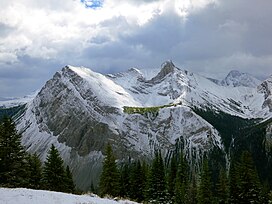| Marvel Peak | |
|---|---|
 Marvel Peak seen from Wonder Pass area Marvel Peak seen from Wonder Pass area | |
| Highest point | |
| Elevation | 2,708 m (8,885 ft) |
| Prominence | 488 m (1,601 ft) |
| Parent peak | Mount Byng (2965 m) |
| Listing | Mountains of Alberta |
| Coordinates | 50°51′35″N 115°33′05″W / 50.85972°N 115.55139°W / 50.85972; -115.55139 |
| Geography | |
  | |
| Interactive map of Marvel Peak | |
| Location | Alberta, Canada |
| Parent range | Blue Range Canadian Rockies |
| Topo map | NTS 82J13 Mount Assiniboine |
| Geology | |
| Rock age | Cambrian |
| Rock type | Sedimentary rock |
Marvel Peak is a 2,708-metre (8,885-foot) mountain summit located in the southern tip of Banff National Park, in the Canadian Rockies of Alberta, Canada. Marvel Peak is situated in the Blue Range, three kilometers from the Continental Divide, and not visible from any road. Marvel Peak's nearest higher peak is Wonder Peak, 3.29 km (2.04 mi) to the north-northwest.
History
Like so many of the mountains in and around Kananaskis Country, Marvel Peak received its name from the persons and ships involved in the 1916 Battle of Jutland, the only major sea battle of the First World War. It was named in 1917 by the Interprovincial Boundary Survey after HMS Marvel which was a destroyer involved in the Battle of Jutland. An alternate view is the name is simply descriptive, similar to Wonder Peak to the north. The mountain's toponym was officially adopted in 1934 by the Geographical Names Board of Canada.
Geology
Like other mountains in Banff Park, Marvel Peak is composed of sedimentary rock laid down during the Precambrian to Jurassic periods. Formed in shallow seas, this sedimentary rock was pushed east and over the top of younger rock during the Laramide orogeny.
Climate
Based on the Köppen climate classification, Marvel Peak is located in a subarctic climate zone with cold, snowy winters, and mild summers. Winter temperatures can drop below −20 °C (−4 °F) with wind chill factors below −30 °C (−22 °F). In terms of favorable weather, June through September are the best months to climb. Precipitation runoff from the mountain drains into Owl Creek and Marvel Creek, which find their way into Spray Lakes Reservoir.
Gallery
-
 North aspect of Marvel Peak above Marvel Lake
North aspect of Marvel Peak above Marvel Lake
-
 Marvel Peak seen from northeast.
Marvel Peak seen from northeast.
-
 Marvel Peak (left foreground) is near Marvel Lake (the long one) and Lake Gloria (behind).
Marvel Peak (left foreground) is near Marvel Lake (the long one) and Lake Gloria (behind).
See also
References
- ^ "Marvel Peak, Alberta". Peakbagger.com. Retrieved 2019-09-14.
- ^ "Marvel Peak". Bivouac.com. Retrieved 2019-02-05.
- ^ "Marvel Peak". Geographical Names Data Base. Natural Resources Canada. Retrieved 2019-02-05.
- Battle of Jutland Alberta Historic Places
- "Marvel Peak". cdnrockiesdatabases.ca. Retrieved 2019-09-14.
- Place-names of Alberta. Ottawa: Geographic Board of Canada. 1928. p. 84.
- Belyea, Helen R. (1960). The Story of the Mountains in Banff National Park (PDF). parkscanadahistory.com (Report). Ottawa: Geological Survey of Canada. Archived (PDF) from the original on 2015-10-02. Retrieved 2019-09-13.
- Gadd, Ben (2008). Geology of the Rocky Mountains and Columbias.
- Peel, M. C.; Finlayson, B. L.; McMahon, T. A. (2007). "Updated world map of the Köppen−Geiger climate classification". Hydrol. Earth Syst. Sci. 11 (5): 1633–1644. Bibcode:2007HESS...11.1633P. doi:10.5194/hess-11-1633-2007. ISSN 1027-5606.
External links
- Weather forecast: Marvel Peak
- Parks Canada web site: Banff National Park
| Places adjacent to Marvel Peak | ||||||||||||||||
|---|---|---|---|---|---|---|---|---|---|---|---|---|---|---|---|---|
| ||||||||||||||||